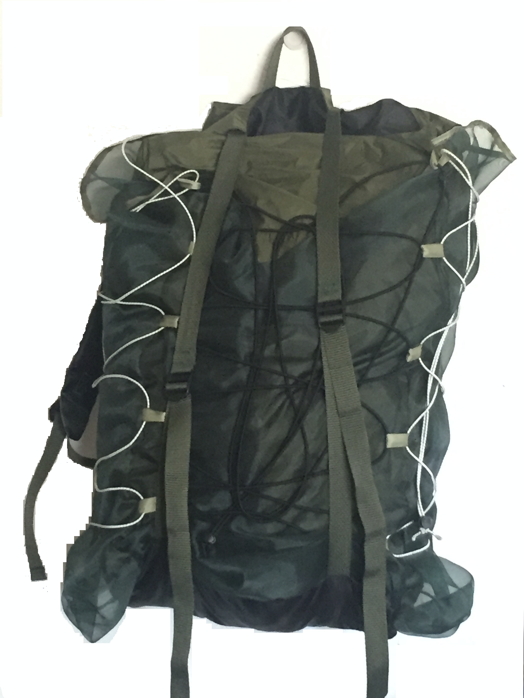

 |
 |
 |
Guest - Not logged in | |||||||||||||||||||||||||||||||||||||||||
Reviews > Do It Yourself > Pack Kits > Quest Outfitters G4 Backpack Kit > Owner Review by Mike LipayQuest Outfitters G4 Backpack
Owner Review by Mike Lipay
November 2, 2020
Product Description 
The G4 DIY Backpack was designed by Glen van Peski (founder of Gossamer Gear that sells the actual G4 pack) and was at the time I built my first one available as a free pattern. The rights to the pattern have since been acquired by Quest Outfitters, that sells the product in several different configurations to suit the individual, from a pattern-only product to a full kit including the patterns, hardware, and fabric. As of the time of this review the prices and options are as follows (all prices US):
Build Report Since I got the plans before Quest Outfitters started selling their kits I had to scrounge around to get all of the different parts, with their kits it is a lot easier (made one for my son out of the kit). For the fabric I cut up an old tent, the tent was waterproof so the pack was as well. Even some of the hardware was able to be scavenged from the tent and other supplies I had around the house. For me the entire backpack ended up costing only about $20 US. My pack ended up weighing in at 15 oz (425 g), but that was because I decided to go with the sewn-in foam padding for the shoulder straps and hip belt, the other option is to use hook & loop fasteners so the straps and belt can be opened and stuffed with socks, shirts, etc., to provide the padding. Using this option the pack would weigh in at around 12 oz (340 g). A few notes here on the pack and its options. The original design calls for 220D Oxford fabric for the parts that will receive more abuse, such as the back and bottom. The remainder of the pack is made of 1.9 oz ripstop nylon. To handle even more abuse 330D Oxford is available as an option, this will increase the weight of the pack. Though not listed other fabric options are available by contacting Quest Outfitters, such as: 1.1 oz Silnylon in place of the 1.9 oz, or Cordura in place of the Oxford, both will change the weight of the pack as well as its endurance. Following the pattern yields a 4400 cu in (72 L) pack. With ample knowledge of gear dimensions, and a bit more sewing knowledge, the pack can be adjusted to provide more or less room. On my second build I eliminated the wider tube-shaped bottom of the pack, streamlining it into a basic rectangle that allowed for easier sewing and material cutting, yielding a 5300 cu in (86 L) pack that better fit my winter tent and sleeping bag. The patterns and instructions require some moderate degree of sewing knowledge. While the patterns themselves are easy to trace onto the desired fabrics and cut out, I had to do a lot of internet searches, calls to Quest Outfitters, and visits to JoAnn Fabrics to ask questions on the terminology (fortunately everyone was very helpful):
Despite all of this, and once I understood everything, the making of the backpack wasn’t all that difficult. Most of the stitching is straight, so even a novice like me had little trouble. The only real issue was the bottom of the pack where the sleeping back goes, it’s a curved section where a lot of pieces come together. It took me quite a few attempts at stitching and unstitching before I got it right, but a little patience got the pack done. Usage ReportSo, how well does it work? My son and I took our packs backpacking down the Grand Canyon on a three-night trip. Loaded with tent, sleeping bag, pad, food, and other assorted gear the pack weighed in at 18 lb (8.2 kg). We went down the South Kaibab Trail (7.3 miles, 4,780 ft elevation loss - 11.7 km and 1.5 km respectively). A hard trail, but with such a light pack the trip was easy. On my back it felt very comfortable, I couldn’t tell that I wasn’t wearing my old frameless backpack. I was very impressed with just how good it felt. On day four hiking up Bright Angel Trail wasn’t a breeze (never is) but the pack felt good all the way up. The trip up was 9.3 miles, with a 4,380 ft elevation gain (15 km, 1.3 km respectively). Of course, without the food and other consumable items the pack was a few pounds lighter. I used the pack for three years before deciding to build a new version that matched my needs more. Still the same basic G4 design, just without the sleeping bag bulge at the bottom so the sewing was easier, and a few other personal differences. But, that’s one of the reasons for making a pack instead of buying an off-the-shelf version. The main outside pouch works great for a place to stuff my tent. Keeping it outside makes it easy to grab when it’s raining. I can then assemble the tent without opening the pack, so the contents aren’t exposed to the weather. I use another of the outside pouches to store the tent poles. SummaryThe Quest Outfitters G4 backpack is an excellent pack with several great features, and a pack design that allows for easy changes to personalize it.
Read more reviews of Quest Outfitters gear Read more gear reviews by Mike Lipay Reviews > Do It Yourself > Pack Kits > Quest Outfitters G4 Backpack Kit > Owner Review by Mike Lipay | ||||||||||||||||||||||||||||||||||||||||||